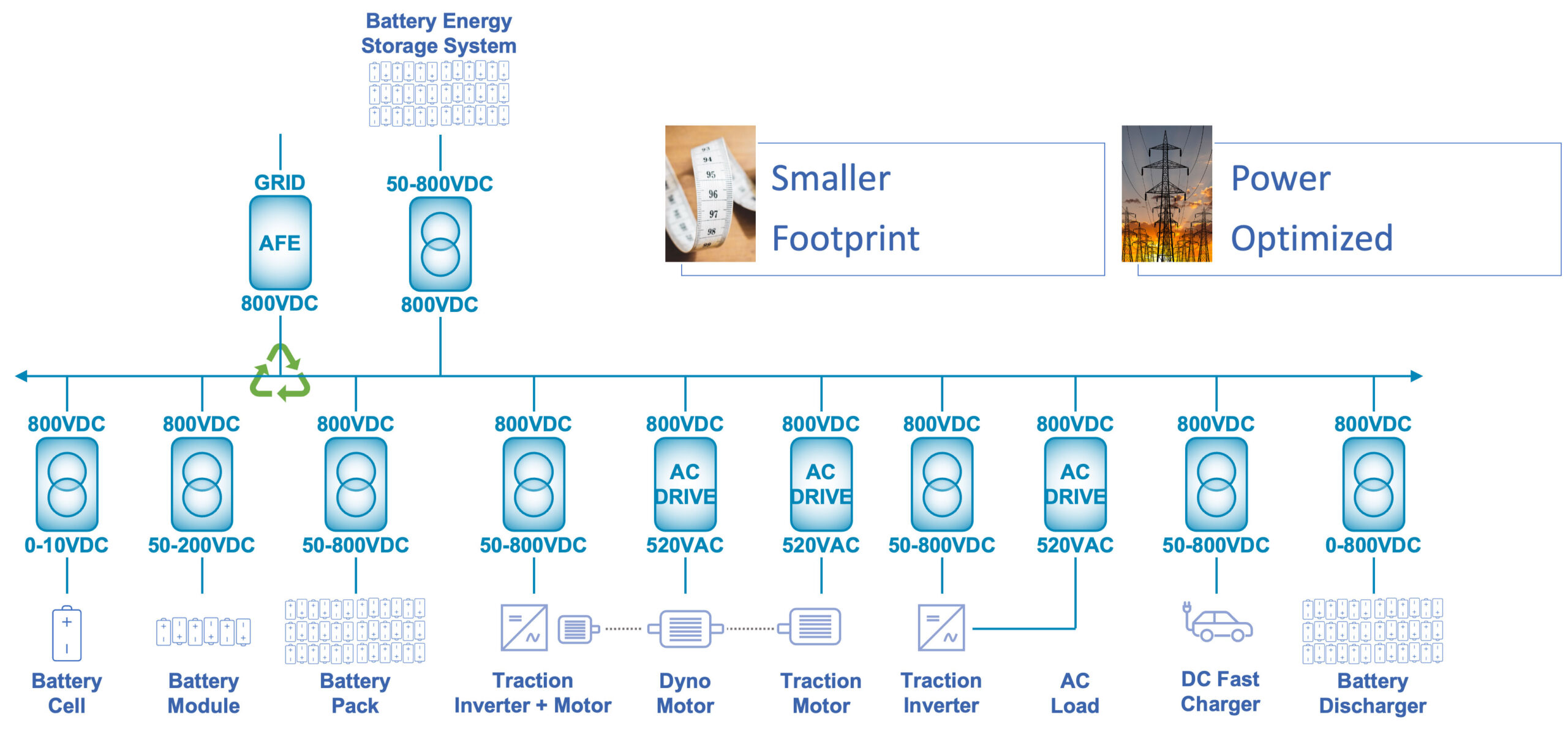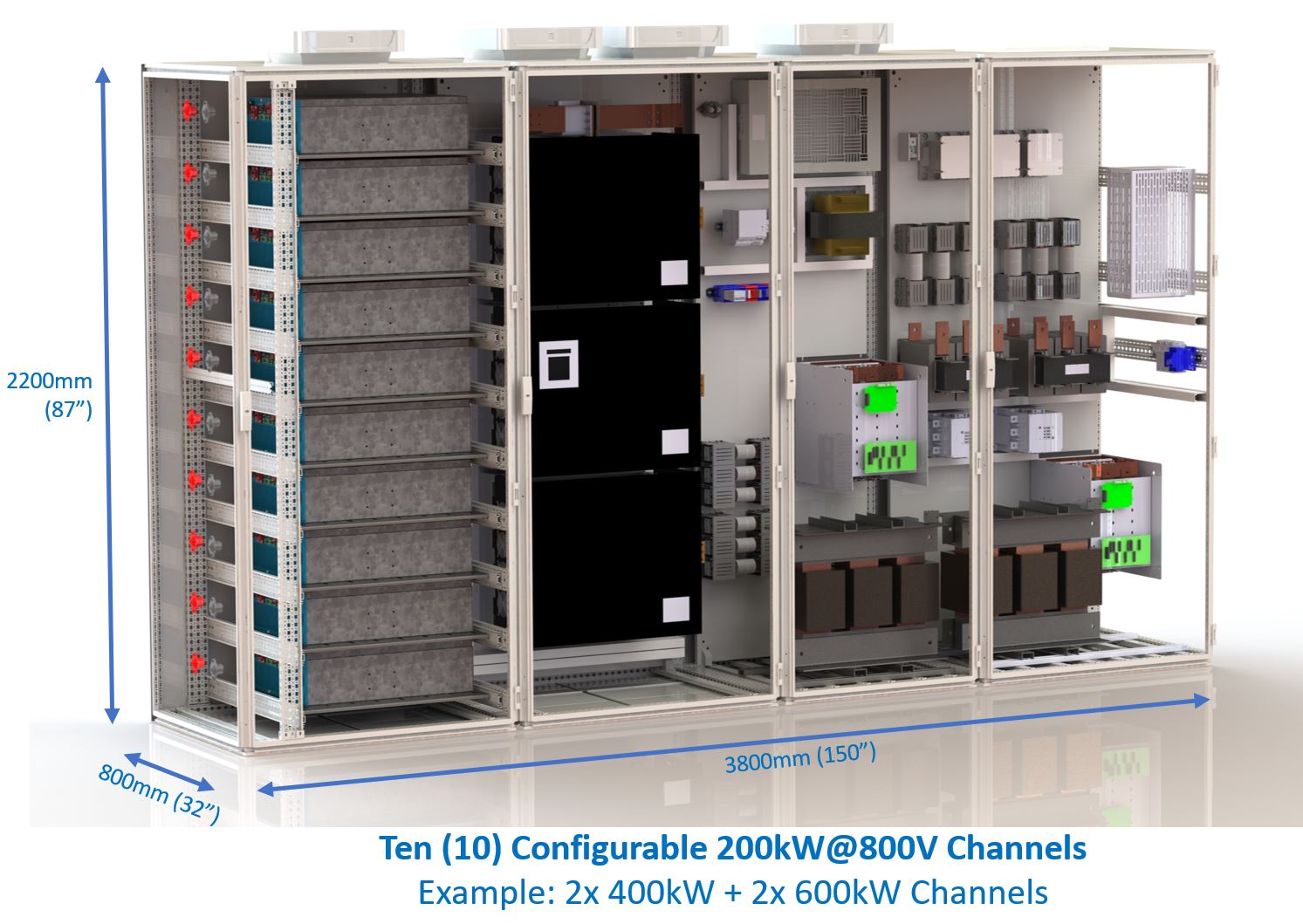Quantum Drive Platform
Unico’s new Quantum Drive Platform is a universal test system platform designed specifically for development and testing of EV powertrains.

Unico’s new Quantum Drive Platform is a universal test system platform designed specifically for development and testing of EV powertrains. The unique capability of combining multiple AC and DC outputs into a common DC drive system with isolation on all the channels gives true multipurpose capability for EV development and test labs. In addition, the system has the capability to have a Battery Energy Storage System (BESS) connected to the DC bus to allow the reuse of test energy.
Specifically for battery testing, the Quantum Drive Platform can be configured to test multiple cells, modules, and packs all in the same system with isolation between all the channels. The use of high frequency transformers provides the channel-to-channel isolation and also removes the need for low frequency transformers mounted internal or external to the systems.
Two significant benefits come from this platform – substantially reduced footprint and reduced energy use. The systems can have a power density approaching 50kW/sq. foot.
One example of this multichannel test systems is this 10 channel system which provides the capability of testing two (2) dual port battery packs, each with a 400kW channel for the “front axle” and a 600kW channel for the “rear axle”.
The 1100 accommodates a broad range of performance requirements. Units may be configured for constant-torque operation for heavy-duty cyclic loads, variable- torque operation for medium-duty requirements, or extended-torque operation for centrifugal loads such as fans and pumps. The drive operates in a transducerless vector control mode that does not require a feedback device and produces full torque to base speed with full starting torque. For demanding applications, an incremental encoder or resolver interface can be added for precise position, velocity, and torque regulation and improved dynamic performance. Dual- and triple-encoder interfaces are also available for position-following or dual-transducer applications. Variable-frequency control is alternately available for applications that do not require critical velocity or torque control. Several controller options are available to meet differing application requirements.
The 1100 can operate any standard- or inverter-duty AC induction or synchronous motor, making it ideal for retrofits and new applications alike. A unique, proprietary digital current regulator (DCR) tunes the drive continuously in real time, eliminating the usual current-loop tuning process required by conventional drives. Digital space vector (DSV) control can be selected for reduced motor noise and low current ripple.
Once routine electrical connections have been made, simple-to-use auto-tuning features adjust virtually all motor- and load-dependent parameters. No motor maps are required. Simply enter basic motor information from the nameplate, and the advanced setup routines do the rest. The drive is completely tuned within minutes.
A wide variety of software options is available to tailor the 1100 to an application, from a fully featured velocity/torque control for general purposes to a host of powerful programs pre-engineered for specific applications. Customization is possible with many programs using UEdit™, a Windows-based programming tool that lets users extend an application using IEC 1131 standard ladder diagrams and function blocks.
A keypad and liquid crystal display provide a simple interface for setting and viewing operating parameters and diagnostics. All controller settings are made digitally for precision and repeatability. Readouts and fault messages are displayed in readily understandable language. An optional graphic display provides a variety of visual formats for accessing drive information.
A built-in high-speed synchronous communication port allows the motion of multiple slave drives to be precisely coordinated. With optional master/slave software, the velocity ratio and position phasing of the drives can also be controlled. Multiple motors can be operated in parallel from a single drive using variable-frequency control.
A built-in link choke provides near-unity overall power factor and low harmonic line currents at all motor speeds. Units with a constant-torque rating of 125 hp or more provide a six-phase (12-pulse) configuration as standard for further minimizing line harmonics in critical applications. Those units are also available on special order with a nine-phase (18-pulse) configuration.
The 1100 monitors its operating conditions and provides a comprehensive set of overload, short circuit, and other electronic protective features to ensure safe, reliable operation. Faults indications are displayed in plain language. A log maintains a history of fault occurrences and externally triggered events.
A fully isolated RS-422/485 serial interface is provided for connecting the drive to a process controller, communication network, or programmable controller. A variety of popular communication protocols is available. The 100 MHz module also accepts an AnyBus module with numerous industry-standard protocol options and a MaxStream module for wireless communications. An RS-232 connection is also provided on 40 and 100 MHz controllers for connecting a personal computer. Windows-based PCs can set up, monitor, and control a network of drives using optional DriveLink™ or UEdit™ software. Optional UView™ software allows users to build their own graphical HMI for browser-based monitoring. Drive Archive™ and Drive Chart™ for the Palm OS make it easy to save and restore setups and capture charts using a handheld computer.
Compact and rugged, the 1100 is available either enclosed or as an open chassis for mounting inside an enclosure. Both versions can be foot-mounted to a wall or subplate or flange-mounted through a cutout to dissipate heat outside an enclosure.


Since battery testing consists of low and high power use as well a both charging and discharging steps, with simple planning you can reuse the energy between the channels. In fact, due to that both packs are rarely using full power at the same time, the AFE size can be reduced and you can still complete all your battery testing based on your desired diversity factor. This can substantially reduce the needed grid connection for the facility.
Please stay tuned for more information or CLICK HERE to contact us to set up a discussion about how our new Quantum Drive Platform can help you achieve new levels of space and energy optimization for your EV test facilities.
The new Unico Quantum Drive Platform will support a wide range of applications for both AC and DC applications.
Specifically for battery testing (DC), the new platform will support:
Four power ranges available:
Our sales professionals are eagerly awaiting your questions. Fill out the form below and we’ll be in touch. If you’re looking for product support click here
| Cookie | Duration | Description |
|---|---|---|
| cookielawinfo-checkbox-analytics | 11 months | This cookie is set by GDPR Cookie Consent plugin. The cookie is used to store the user consent for the cookies in the category "Analytics". |
| cookielawinfo-checkbox-functional | 11 months | The cookie is set by GDPR cookie consent to record the user consent for the cookies in the category "Functional". |
| cookielawinfo-checkbox-necessary | 11 months | This cookie is set by GDPR Cookie Consent plugin. The cookies is used to store the user consent for the cookies in the category "Necessary". |
| cookielawinfo-checkbox-others | 11 months | This cookie is set by GDPR Cookie Consent plugin. The cookie is used to store the user consent for the cookies in the category "Other. |
| cookielawinfo-checkbox-performance | 11 months | This cookie is set by GDPR Cookie Consent plugin. The cookie is used to store the user consent for the cookies in the category "Performance". |
| viewed_cookie_policy | 11 months | The cookie is set by the GDPR Cookie Consent plugin and is used to store whether or not user has consented to the use of cookies. It does not store any personal data. |